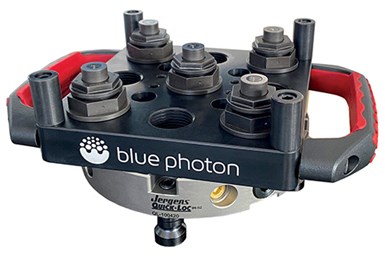Adhesive Workholding Pallet System Designed for Complex Parts
Blue Photon’s Grip Pallets are designed for quick-change and adhesive workholding of complex and hard-to-hold parts for EDM, grinding, inspection, laser and milling operations

Blue Photon has added five Grip Pallets and three new inserts for 52- and 96-mm quick-change receiver systems. The addition enables more applications using existing fixturing systems in machining centers. These grip pallets are designed to simplify how parts are loaded, reduce scrap and increase spindle uptime.
Available in 150-, 225- and 300-mm square pallets, the pallets are designed for quick-change and adhesive workholding of complex and hard-to-hold parts for EDM, grinding, inspection, laser and milling operations. The pallets can hold parts securely, providing increased machining access on five to six surfaces while using standardized fixturing systems already in place, the company says.
The grippers are inserted into new external inserts, designed specifically for the pallets. The external inserts are available for use with small, medium and large grippers. The new inserts are said to enable simple installation of the grippers at the required height for maximum holding power.
The 150-mm square pallet is available in aluminum and steel with a 52-mm pattern for a quick-change receiver that will hold up to nine grippers. The 225-mm square pallet is available in aluminum and steel with a 96-mm pattern for a quick-change receiver that will hold up to 21 grippers. The 300-mm square pallet is available in aluminum with a 96-mm pattern for a quick-change receiver that will hold up to 33 grippers.
Each pallet includes two handles with multiple color choices and four spacers, with a 25.4-mm standoff that enables the recommended nominal of 1-mm joint thickness between gripper and part. Optional clamp studs are available for both 52-mm and 96-mm patterns for 5th axis, Jergens, Lang and Mate systems. Part can be removed with a ¼ turn twist of the gripper or hot-water soak. Residual adhesive is removed by using a handheld steamer or a hot-water soak and a light peeling action.
RELATED CONTENT
-
Tools and Technologies for Deep Hole Drilling
Understanding the challenges of deep hole drilling and knowing how to select and apply the appropriate tools will help a shop profit from this operation.
-
Understanding CNC Collet Chucks
Workholding for turning is usually fairly basic: The selection comes down to chucks or collets. This article looks at when to consider the collet chuck and what kind might be best for a given application.
-
A Guide to Insert Coating Processes and Materials
Few materials have had a greater impact on our economy and industrialized culture than cemented tungsten carbide.


.JPG;width=70;height=70;mode=crop)
